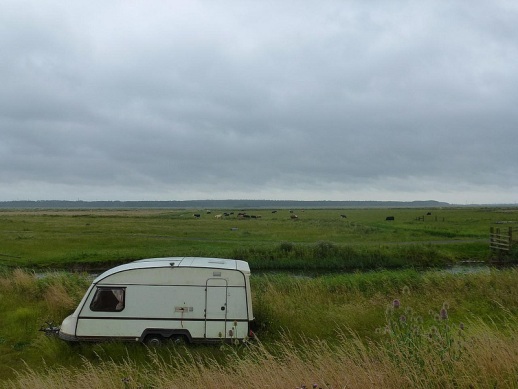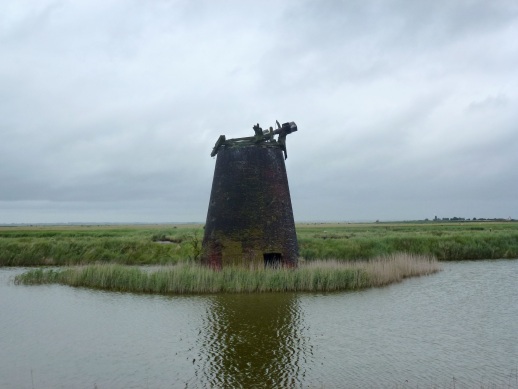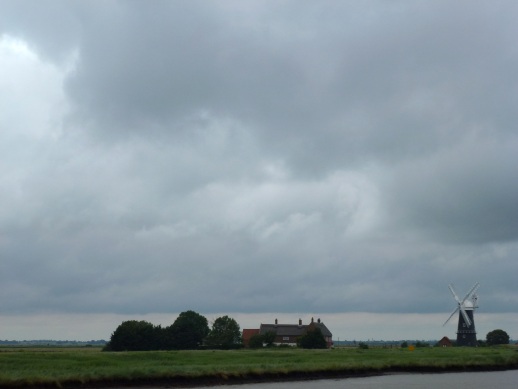
Words and pictures by Nic Flook
Where the rivers Yare and Waveney meet on the border of Norfolk and Suffolk, is Haddiscoe Island. With local landmarks such as a ruined priory, a Roman castle, Skeleton wood and Raven Hall, one could be forgiven for believing they were about to step into the world of a 19th Century gothic novel. Under a sky that evoked the atmosphere of November rather than the mid-June day that it was, I set out with my friend Bob, a regular visitor and native Broadsman, to walk around the island’s perimeter path.
In the 18th Century, a group of merchants from Norwich planned to circumvent the system of transhipment charges imposed on their imports by customs officials in Great Yarmouth, by forging a new route to the coast. The merchants employed engineers to design and build a harbour in Lowestoft and join the rivers Yare and Waveney with a 2.5 mile long, straight channel known as the Cut, that would create a direct shipping route from Norwich to the north-sea. The project was completed in 1833 though in less than a few decades the use of wherries and barges for commercial transport fell into obsolescence with the introduction of rail. As a legacy of the merchant’s endeavours, the excavation of the Cut created a wedge shaped islet, that is today, separated into marshy meadows by a network of drainage ditches. Much of the land in the area was bought and sold on short-term leases by farmers at auctions held in a back room of the Bell Inn at St Olaves. The farmers used wind powered pumping mills to keep the rising water at bay. These were succeeded by diesel powered pumps and then electric. Electricity being a fairly recent introduction for the islanders. The modern electrical ones are housed in compact, rectangular, brick-built sheds, in some cases at the foot of their predecessors. Two of the original mills on the island were bought and renovated to become homes.

Though there are the remains of several others, albeit in the advanced stages of decay. Each conical ruin has been damaged by years of exposure to high winds, lightning strikes and flooding, that speeds their entropy. Bob and I left his car beneath the concrete bridge at St Olaves and began our walk along the tow-path that runs parallel to the Cut, where some houseboats were moored bow to stern beneath two enormous pylons. A rented pleasure boat puttered along, slower than our walking pace in the green water and veered towards the wrong side of a scarlet, shallow water marker. The pilot waved to us, perhaps surprised to see two people walking the towpath after he had navigated what can be such a quiet backwater. Whether part of the human condition or out of politeness, the compulsion to greet a stranger – so that we are strangers no more – can be great in a landscape that is equal parts beautiful and bleak.
The main footpath spans three sides of the island and rises up so that one walks above the level of the marshes for the whole 12 miles. Oyster catchers and dunlings pattered on the wet mud around a miniature archipelago at the river’s edge, their smooth bodies stark against the brown, foot-high silt cliffs covered in tufts of sedge. The tower of St Andrew’s church was just visible above the tree line at Wickhampton, a couple of miles to the West. St Andrew’s used to stand at the edge of an estuary that stretched all the way to the coast until the water was drained. Prior to the reclamation of the land, the church’s situation would have been similar to that of St. Botolph’s at Iken, that overlooks the river Alde only metres from the swathes of rushes and the Godwits that probe its muddy banks. Closer to the margins here on the Yare, among the tall trace-like green reeds, shallow pools reflected the moving sky. A warm, wet Spring coupled with the fertile peat-rich soil had produced an incredible profusion of grasses, nettle, thistle, hogweed and dock, interspersed with stalks of stray feed crops and even the occasional rose bush. The plants were up to our chests for most of the route and our legs were covered by the thick, damp undergrowth that snagged at our boots. We progressed slowly along the roddon, observing the different coloured snails and slugs that tumbled to the ground or suckered onto our clothes as we parted the tall stalks of hogweed and thistle. Near a bend in the river was a section of path that had been trodden flat and cropped in places, with a mound of shiny sheep shit near one edge. Bob said that he had heard that a rogue ewe had been seen on the island. The only sheep nearby were a small flock, kept on the opposite bank of the river, behind a low-barbed wire fence. Could she have leapt the fence and swam to the island? As the tide is drawn out through the estuary at Breydon Water, the gentle swirls on the river’s surface belie the powerful rip that churns beneath. Crossing the river here would be have been a formidable challenge, even for the most intrepid ovine escapologist.

To know and the respect the rivers here has always been an important part of island life. Mail and telegrams used to be delivered to the Berney Arms pub or Seven Mile house where a bell would be rung and someone would fetch the missives by boat. This was the case for ‘Yolton’ Hewitt, who lived with his wife in Raven Hall, a thatched house opposite the Berney Arms mill and pub. He also used to deliver milk by boat to the nearby station, for transport to the surrounding towns. When the flood of 1953 struck the area, the island was submerged and cut-off for seven weeks.
The potential flood risk for such a low-lying area means that the 2000 acres of marshland are only suitable for summer grazing. Dairy herds came from as far as Ireland at one time to feed on the rich pasture, local herds are still tended by the descendants of families that have lived on Haddiscoe island for over a century. On the river Waveney side of the island, overlooked by the ruined walls of the roman settlement of Burgh castle, herons and egrets wheeled overhead. Their awkward forms looked like rags on sticks, as they bared themselves to the strong breeze. A pair of juvenile marsh harriers were being tutored by a parent. A predators hunting instincts have to be honed in this competitive habitat, where raptors are numerous. I was told by Bob that rough legged buzzards, peregrines and sparrowhawks also hunted over these marshy enclosures, hanging in the air, watchful for the movement of a vole, shrew or mouse. As the path started to become overgrown again, we turned away from the river and walked alongside another reed bed. Our voices provoked a muntjack deer to stop nibbling the bank and lollop away into the long dark reeds. The rain became harder, whipped around by the wind, at first it blew spray into our faces, then at our backs, then into our faces again. With half opened eyes, we were startled by a short eared owl that blustered out of the dense scrub beneath us. The owl launched itself upwards then soared low over the marshes, with flashes of its pearlescent wings. The near-horizontal topography in this part of East Anglia meant that one could see the change in weather as it approached. The purple darkness that had loomed up on the horizon just 20 minutes or so ago, had arrived above us and a siege of thunder seemed to rock the ground.
The downpour intensified. A pheasant broke cover, ran across our path and ducked under the base of a neat conifer hedge. The sharp, oily aroma of the trees hung in the damp air as Bob lead me down across a disused dyke that ran alongside the only surfaced road I’d seen the island. At the roadside we found an old shed made of blackened boards with its roof felt peeled back, long abandoned. It was almost completely covered by a wild, shaggy hedgerow. We removed the wooden prop that had kept the door closed and carefully lifted up a bushy ball of hawthorn that blocked the entrance. Inside were some old long-handled tools, a half empty drum of fertiliser, some feed sacks and just enough room for us to shelter. Sallow tendrils of ivy had probed in through gaps in the wooden walls. Moths fluttered in the musty air as we watched the flashes of lightning through a crack in the door and listened to the rain against the roof. After a short while we could hear that the rain had eased and the sky became brighter. I pushed the door open wide enough to see the grass verge by the road which was now bisected by a thick stripe of sunlight. We left the shed, propping the door closed once more, thankful for the shelter and joined the metalled road again. The clouds blew out to the east over the sea to reveal a cornflower blue sky, and the landscape – whose colours for most of the day had been muted by a pall filter – regained its vibrant greens, golds and browns, refreshed by the rain and illuminated by the afternoon sun.